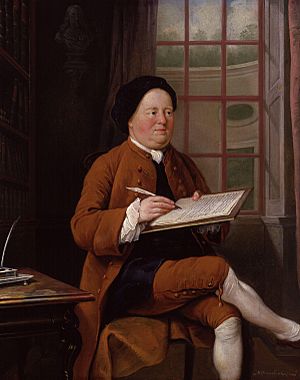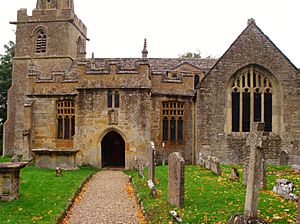Sarah Chapone facts for kids
Quick facts for kids
Sarah Chapone
|
|
|---|---|
| Born | Sarah Kirkham 11 December 1699 Stanton, Gloucestershire, England |
| Died | 24 February 1764 (aged 64) Stanton, Gloucestershire, Great Britain |
| Nationality | English |
| Period | 18th century |
| Notable works | The Hardships of the English Laws in Relation to Wives |
| Children | 5 |
| Relatives | Hester Chapone (daughter-in-law) |
Sarah Chapone (born Sarah Kirkham on 11 December 1699 – died 24 February 1764) was an English writer. She thought a lot about laws and wrote many letters and short books. She is most famous for her important book, The Hardships of the English Laws in Relation to Wives. This book was published in 1735 without her name on it.
Contents
Sarah Chapone's Life
Sarah Chapone lived and wrote in England in the mid-1700s. This time was called the Georgian era. During this period, Robert Walpole was a very powerful leader in the English government. There were also many wars between England and France.
Her Early Life and Family
Sarah Kirkham was born in 1699. Her parents were Damaris and Reverend Lionel Kirkham. Her family worked for the Church of England. She grew up in her father's home in Stanton, Gloucestershire. This area was quite far away from big cities back then.
In 1725, she married Reverend John Chapone. Before she married, a famous church leader named John Wesley wanted to marry her. They later became good friends and wrote letters to each other. After she married, Sarah ran a boarding school for nine years. She also raised her five children. Her family did not have much money. They moved often until John became a vicar (a type of church leader) in 1745.
Her Friendships
Sarah Chapone was very close friends with Mary Delany. They became friends in 1715 when Sarah was 16 and Mary was 15. Mary Delany wrote about Sarah in her own life story. She said Sarah had a "special talent and brave spirit." Mary also said Sarah was very smart and kind.
Sarah Chapone's Ideas
Sarah Chapone's writings show that she believed in women's rights. Even though the word "feminist" wasn't used back then, her ideas were similar to what we call feminist ideas today. She thought that married women in her time were not truly free. She compared their situation to slavery because of the laws.
Her Views on Women's Rights
Sarah Chapone believed that the laws in England were unfair to wives. She thought that women, especially married women, should have more freedom and control over their lives. She argued that parents should not force their children to marry someone they don't want to. She wrote that a parent could choose not to give money to a child who married without their permission. But she also said a parent could not force a child to marry against their will.
Her Intellectual Friends

Sarah Chapone had many smart friends and people she wrote letters to. These included George Ballard and Samuel Richardson. George Ballard was writing a book about important women in Britain. Sarah helped him find information and money for his book. She also told him about the writings of Mary Astell, another important woman writer. Sarah and George also worked together to help Elizabeth Elstob, a scholar who was living in poverty.
Sarah Chapone started writing letters to the famous writer Samuel Richardson in 1750. They mostly communicated through letters. Richardson thought highly of Sarah. He called her "a great Championess for her Sex," meaning she was a strong supporter of women. In their letters, they talked about Richardson's novel Clarissa. They also discussed Sarah's ideas about women's place in society.
Sarah Chapone had some disagreements with parts of Richardson's novel Clarissa. She thought the main character, Clarissa, was too obedient to her father. Clarissa's father forced her to marry someone she did not like. Sarah believed Clarissa should have used legal ways to fight her father's demands.
Her Important Writings
The Hardships of English Laws
Sarah Chapone's most famous work is The Hardships of the English Laws in Relation to Wives. It was published in 1735. Even though it was published without her name, many people knew she wrote it. This book talked about a legal idea called coverture. Coverture meant that when a woman married, her legal identity was covered by her husband's. This meant she had very few rights of her own. Sarah argued that this made the legal situation of English wives similar to slavery.
Remarks on Mrs. Muilman's Letter
Sarah Chapone also wrote Remarks on Mrs. Muilman's Letter to the Right Honourable the Earl of Chesterfield in 1750. She wrote this as a response to a letter by Teresia Constantia Phillips. Phillips's letter was published after her earlier work, An Apology for the Conduct of Mrs Teresia Constantia Phillips. Chapone's Remarks was also published without her name. However, she told Samuel Richardson that she had written it.


